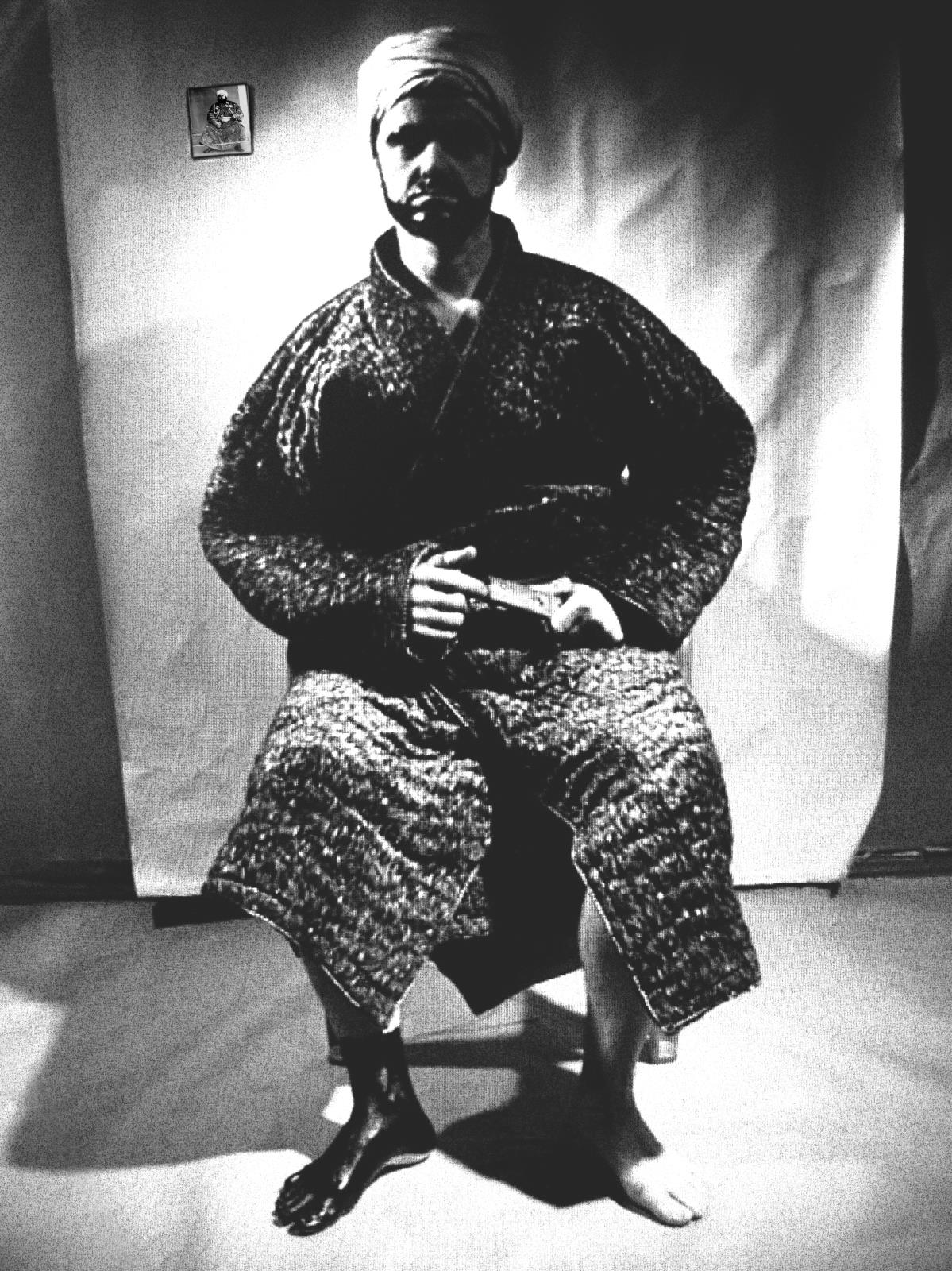Vyacheslav Useinov
ABOUT "FRACTAL VERISM"
Part one
The term "Fractal Verism" refers to the type of artistic research, which does not lose sight of the uniqueness of veracious things, each time different, and yet does not feel doubt about their irrational resources. Work in this area takes place at the crossroads of the poetic instincts, as if assisting the color, and persistent surveillance of the inevitability of our numbers, whose detachment is reinforced by imaginary changeability of fractals, which are optical palimpsest stratification of the general on the general, arcades of the multitudes of (the same) equal messages. A technical manner of execution of creative operations within the fractal verism allows you to single out a huge amount of integral in composition fragments, which in some ways are independent pictures.
I try to use color elements (having, say, a metonymic effect in literary analogies) that provoke a ripple on the surface of the canvas, incredibly similar to the texture configuration of fjords that, with an increase, acquire purity of serene chaos.
In these circumstances, efforts taken in the writing of each pictorial piece, confirm only a Filonov’s thesis on the principle of "the executed" where "every atom must be made to the last degree of perfection and tension". In such an atmosphere the item of the size of three square centimeters has a right to persistently point to itself and dictate our eyes rigorousness of the seen, which has an effect of pulsating fractal stupor. In this regard, I would like to note that when writing aesthetic matter of a small format, it is not an outside play of transparent void that hits the eye, though it can also happen, but a segmented cohesion of the subconscious impulse in the moment of his embodiment. Here eligible is a meticulous fixation of color veins in the picture itself as they are fused into the image as a document of the perception and probably correspond to hallucinatory notion of mathematical models in shape-forming of fractals, where the wandering shadow of inevitable transience in the billionths of a second is risking to fall upon us as natural disaster. In this situation, the visual writing that stretches over time acquires a new conceptual property - the color is focused in distortion of the no-man’s, impersonal "presence" and its derivative transforms a source of ephemerality into the language of numbers. On the way of contemplation of any portion of the painting imagination leaves its imprint and its signs indicating hermas, the coordinate location of the color volume and the light evaporation, in fact, in everyday reality. Anyway, in these creative pursuits, the artist should guess his own, exceptionally particular nature of perception and, usually in the surroundings of rough disorganization of the environment, try to interact with an area of the hall, where his work ceremonially given under control of the polyphony of the space will be exhibited. As a rule, impersonal and non-emotional distance between pictures erases and repeals discomfort in the starting, ownerlessness of always chaotic "sudden" exhibition, filling the viewing perimeter with barely noticeable smoky aura of anticipation. The viewer can get lost in conjectures in search of the most comfortable area to observe the artifacts of artistic adaptations. Moving away from the threshold of the exhibited works, or approaching them on a dark, fabric background, he nonetheless freezes just in his instinctively found and intended only for him place in front of the works on the wall. An ideal point of contact with a specific work in different spaces of time, "wanders", changes its position, and sometimes disappears - here the viewer needs to arm himself with patience and just wait for openness ripening in it, no longer resisting the openness from outside in the pictures painted with the depth of unspoken stupor, work-weariness of microscopic strokes reaching the size of dust itself. And careful approach in showing the works will give us a chance to claim the impossible, the right to be where we turned out to be. In 1993, the shady calmness of the Fergana periphery of my life circumstances intersected with the phrase of Saint-Petersburg poet Arkady Dragomoshchenko: "it does not matter how and what to write, it is important how long to do it". In general, to break his own consciousness like close to the heart old photos, leave illusions no mercy in the tenacious memory which seems to be extinguished, while the History is reborn in the throng of frozen memories, inciting the naturalness of our author's self-sentiment to dare to be within a hair's breadth of artistic risk - with the specter of uncertainty the artist has to come in touch invariably in seclusion of his personal silence. In this air of electrified meditativeness each frame of local land is filled with fractal agility inside of fluidity vital lengthinesses. Art critics or curators are often discouraged about unrecognized artist's hand, thereby signing a verdict to the author in the “unmanifested” and making it hostage to their so-called "style." But genuine, irreversible, achieved through suffering and autochthonous nature of visionary mainlands are open windows for comprehensions created by spontaneity of insights, - they raise the bar on the level of faith in painting, without submitting to the trite plot of well-established knowledge. Some modern artists (for example, Gerhard Richter, Francis Bacon or Anish Kapur ) are endowed with inner strength and ready to radically change the molecular formation of their works, -they exist in multiple poles of their oeuvre that is only indicative of the opening of a new trend and a new aesthetic substratum.
"Fractal verism” has the main feature - to be at the junction of documenting reality within the range of intellectual realia with the irreproachability of taste comprehension, with the accuracy of fractals in painting. In principle, this study is addressed to the irrational grain of contemporary art - it is, I hope, alludes to the danger of succumbing to the cold apathy or, on the contrary, in a panic sentimentalism in the era of total communications and high-tech images.
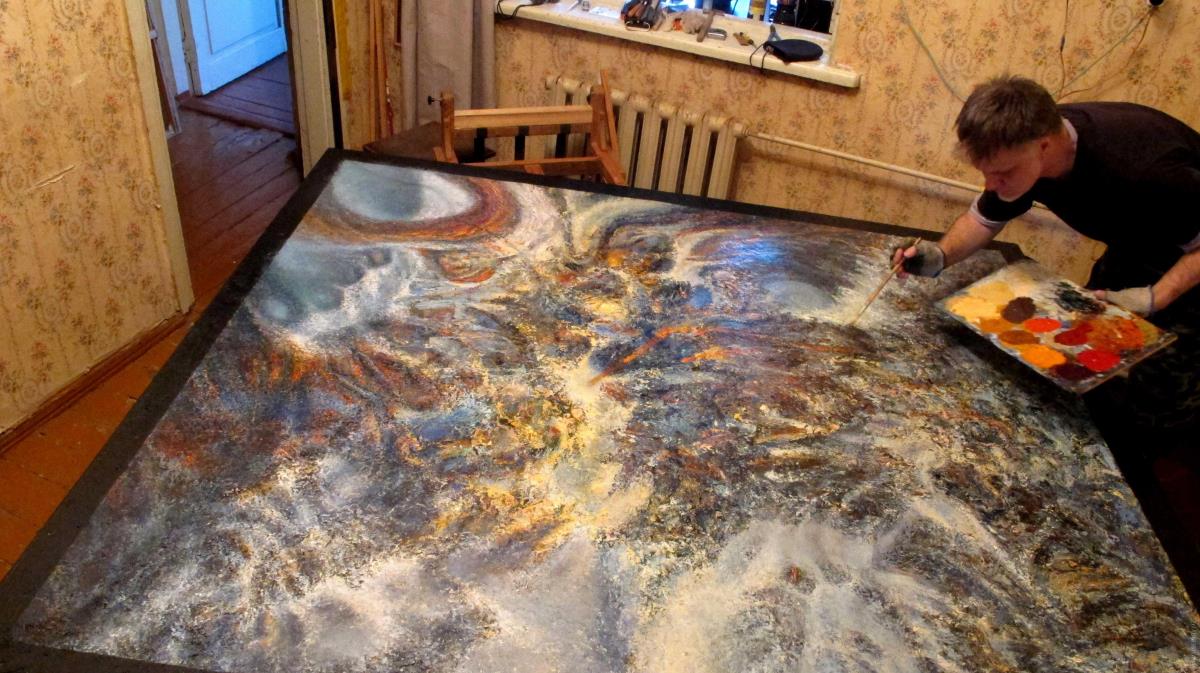
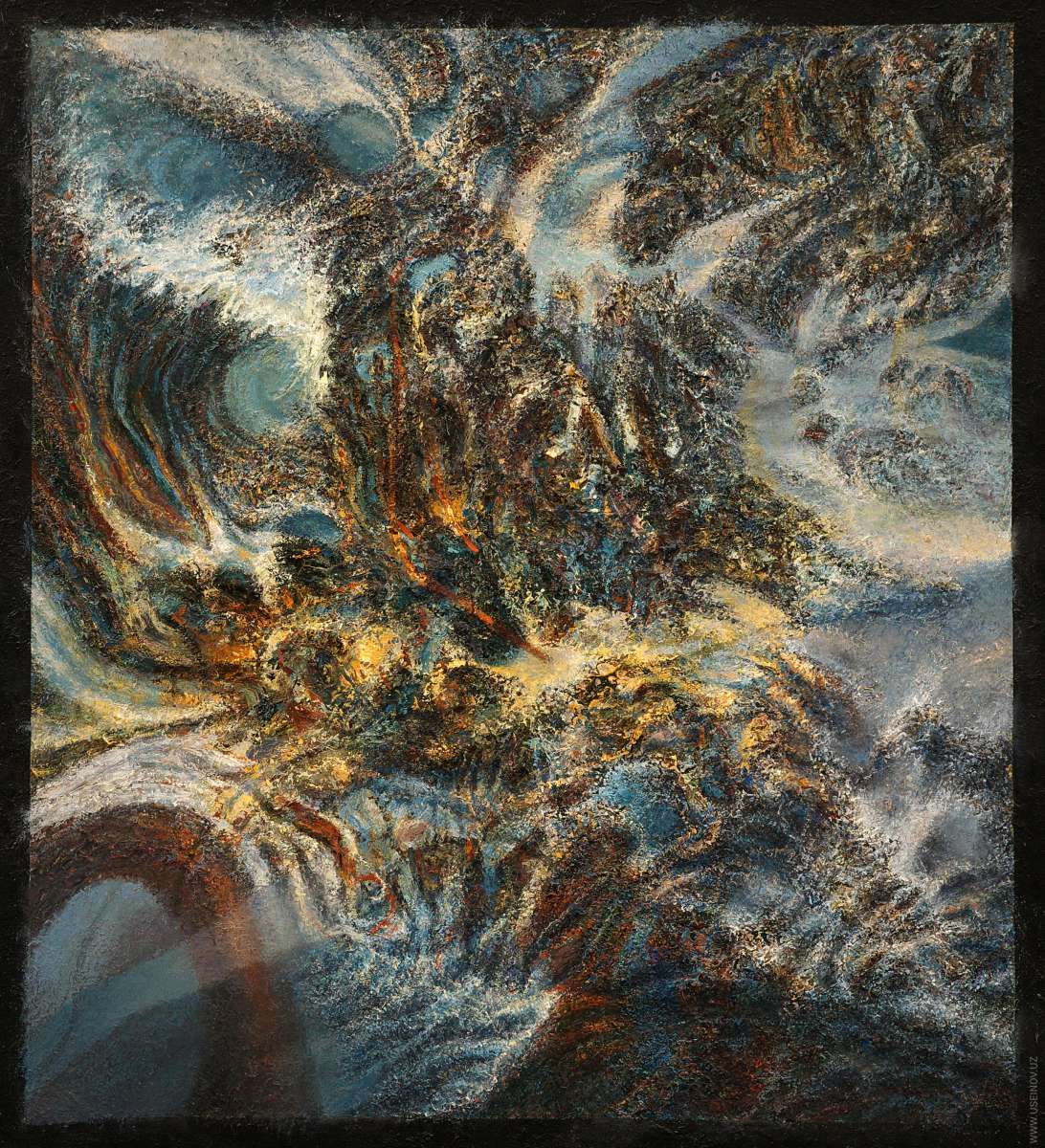
"Landscape behind the wife of a Florentine merchant."
Technique: oil on canvas. Size: 220x200 cm. Tashkent. 2012
The work is in the collection of the author.
"CONSTANT" – THE INSTALLATION OBJECT AS A CONTINUATION OF FRACTAL VERISM
Part two
In the wide-open places of artistry, layered repetitions await one and the same source of a certain inviolability, replicating the shadows of genuineness, of timelessness, of birth and dying. In the foreground of this artistic act giving praise to, first of all, commonplace simplicity remain normal properties of unpretentious naturalness: texture, color, woodiness, fossilization, black and white seeds of light and umber, dense dryness and cool peace, embedded in the ribbing of constructivist silhouettes, in emptiness of factory premises, in material clarity of quiet ecstasy. Here, in fact, you are like folding a similarity of burnt matches by eyes from a metaphor to metaphor, grouping them into a Möebius strip, which infinite resourcefulness you now and then try to interrupt by the imaginary aggressiveness of a "close-up". The increase of the usual things to improbable proportions, as is known, turns them into a notional sign. Perhaps the idea of fluxus ?? as such lies in the lack of ideas, yet the incarnation of such "absence" imparts a special state to us, which fleshliness is being traced in the art object. At some distance and in the vicinity, the simulacra of once accomplished scenes loom like velvetiness of suburban silence, like tuberosity of flickering Muslim graves, like factory rumble of already darkled and melted around rogue districts of Ferghana , resurrected today in the ritual conventions of some installation body. In addition, even in the formlessness of lyrical lawlessness indestructibility of the material world plays its role with the exhaustive uniqueness of the instant. Besides, matches of the hypertrophied size as if crystallize the boundary of some unauthorized, hypothetical arbitrariness and reduce the obviousness of the ego-centric impulse to the scale of chimericality and brevity. Then comes the breakdown (for inflamed fixedness), hidden from the eyes, - the outflow of things naming out of scarcity into scarcity, from their verbal exhaustion, generating the ascetic bliss without images and the abyss, as if on the edge of the Becket’s play "Fin de partie". But it is the ending and collapse that the return the innocence to a paradox or some Escher or Vazarelli. In other words, the stereoscopic code of our permanent expectations languishes in the forsaken territory where the canvas or the installation body are conceived as the poetic audacity, the concentration of life-giving efforts, of new sensations and visual despair. There seems that the surface itself of the aestheticized space winds colored jute, synthetic, a pile of rounded details, obeying the vicissitudes of the unguessed. Under these conditions, the artist uses the theatrical-mimetic collection of situational art, the stock of behavioral collisions in the poetics of performance and histrionic rites resembling a funeral farce of Dadaists, where the audience, on the top of all that, strews its mood in this action, moving mentally on a metaphorical podium after the funeral "carriage". One has the impression that here the density of the iris of an outside observer accompanies around a circle the scenic photogenicy and backs of the people walking as if to otherness of the contemplated world where the prospect of removal will return as importance of the enlarged details, and the landscape will present us, at last, with the depth of the appropriated by it values of once hidden images and phenomena in any lasting point: "Center of the universe is everywhere, and its boundary is nowhere."
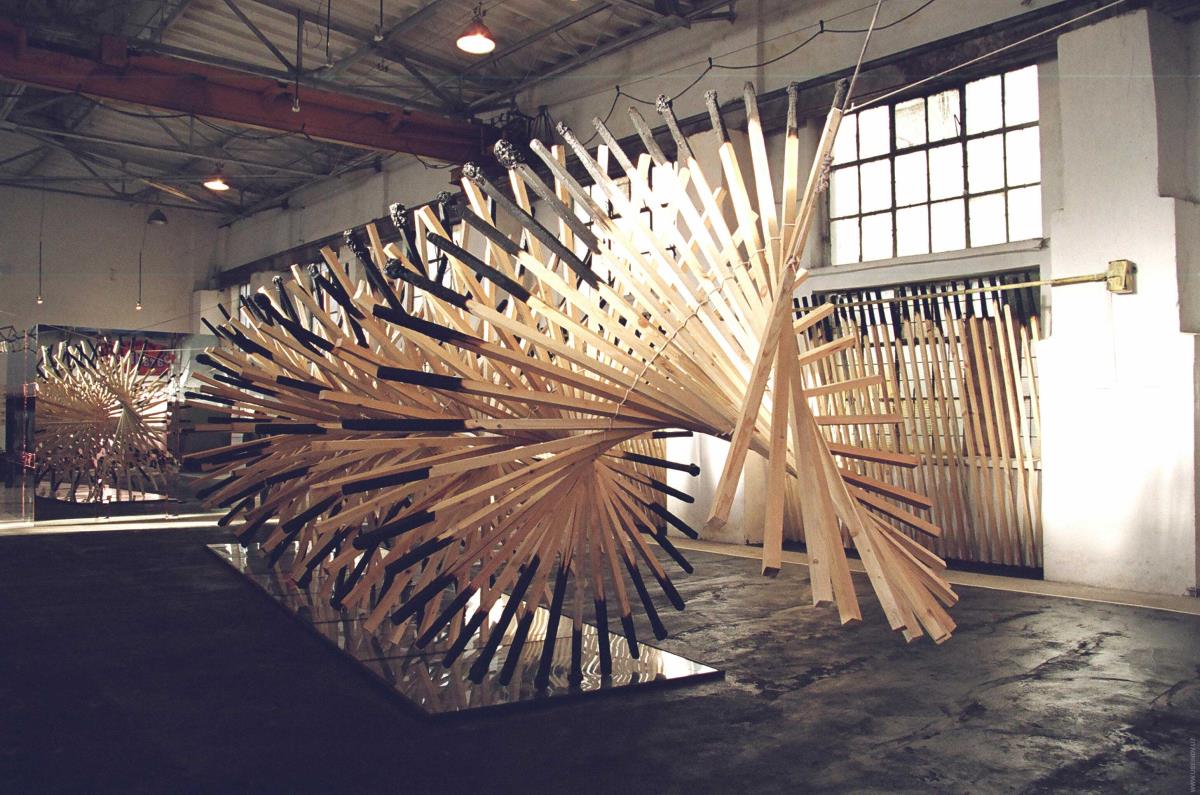
Fractal installation: "Constant".
Technique: wood, plastic, glass, rope. Tashkent. 2005
The work is in the collection of the author.
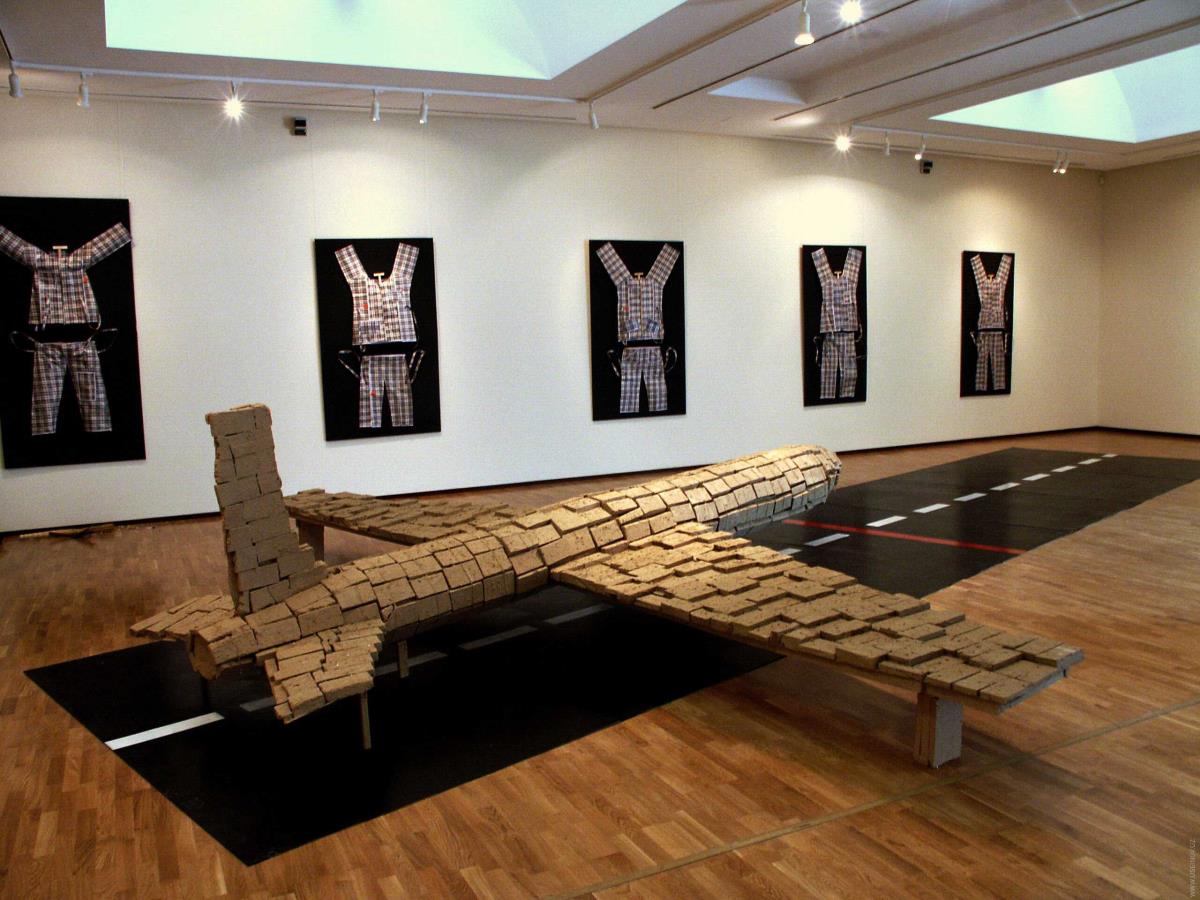
Installation: "Gastarbaytersky flight".
Technique: clay, penaplast, plywood, Chinese bags. Tashkent. 2005
The work is in the collection of the author.
THE TOUCH
Part three
Once you wake up late at night, wrapped in some kind of a new calm and unable to understand: what's wrong? where are you? – something indefinable is happening. Work on the painting is unpredictable. It shows itself as moist air on the glass, at the moment when one hears a dull tapping, insinuative knocks with a humpbacked stone on the wall, but the funeral has taken place. The attentive glances of passer-byes betray their sticking alertness. They do not notice the freezing puddles, ossifying in the outlines of straight lines and reflections of trees and sky become more alienated. Fleeting impression is shaky and unstable like moisture from the warm breath. Only distinctness of the knock which is replaced now by the wind, now by the lightning, then by the bus route terminal picks out the everyday monotony. Sign - period; further - the inevitability with which (let’s add) we as if establish a secret agreement, although, in fact, it controls us. The desire to continue the work without thinking about balance turns into my monotonous daily routine. But to fall off the bike, you need something ... You hold the wheel stronger at such thoughts, and yet it does not save. A flashed series of events is like a point retaining only the mysticism of the day before. And it repeats – sure thing. Physical isolation of the material is an emotional reference point that allows us to capture the artistic fabric of fractal verism. Only the internal openness and intuition permanently keeping alert lead us out to the entirety. A hidden process of creative tension slips losing its sequence, or condenses into a blind, impregnable bond. The feeling of fullness and duration of also vanishes, dissolves in alternation of days, in their count. A psychological vacuum is being formed which from time to time throws us into a new coordinate system. A gaze of black yak on the white snow once seen in the mountains does not allow me to forget the hushed details of the suddenly petrified space through which he was watching me. His invisible presence stays, you find him when you do not think about it. The reference point. And what is important: the rejection of emasculated naturalistic approach and conceptual heaviness transforming the work into an ideological object; the local localness is tirelessly accumulated in every item and we are trying to endow the subject with its own inimitable immediacy. The artist probably carries on the canvas mainly what agitates him at this moment: perhaps death; a landscape in the summer midday heat - just a hint at inevitability endlessly pursuing us. Painting unlike, say, the cinema is closed up in one frame, stating the full statics of this fragment. The internal stress is conjugated with the quality of poetic reality. In Tarkovsky's film "Andrei Rublev", the infinitely lasting finale, panning of the icon of the Trinity, is only one of the versions of the artist’s sensory experience. If we take the icon as an example, in it there is something sacred, unconditional, that brings us to an intimate feeling. The analysis of a continuously developing form, the theoretical pressure over its development humiliate the simplicity and mysteriousness of the creative act. A finely dotted locality leaves marks. The annoying barking of dogs is vanishing in the solitude of streets, goes out, and closed window sashes are listening to the silence. This literally palpable silence imperceptibly passes into the sense of time. The clock is mechanically and dryly working, and the things clenched by room solitariness grow torpid. Color writing and its plastic scheme create a spontaneous image system flowing naturally from the specific uniqueness of the material. Then follows the expectation of something alluring and at the same time understanding of the inner experience doom to prolonged isolation, when every minute you feel that the threshold is nearing; the choice is made. It is only left to observe the ritual of the blind and keep to the necessity which is called reality.
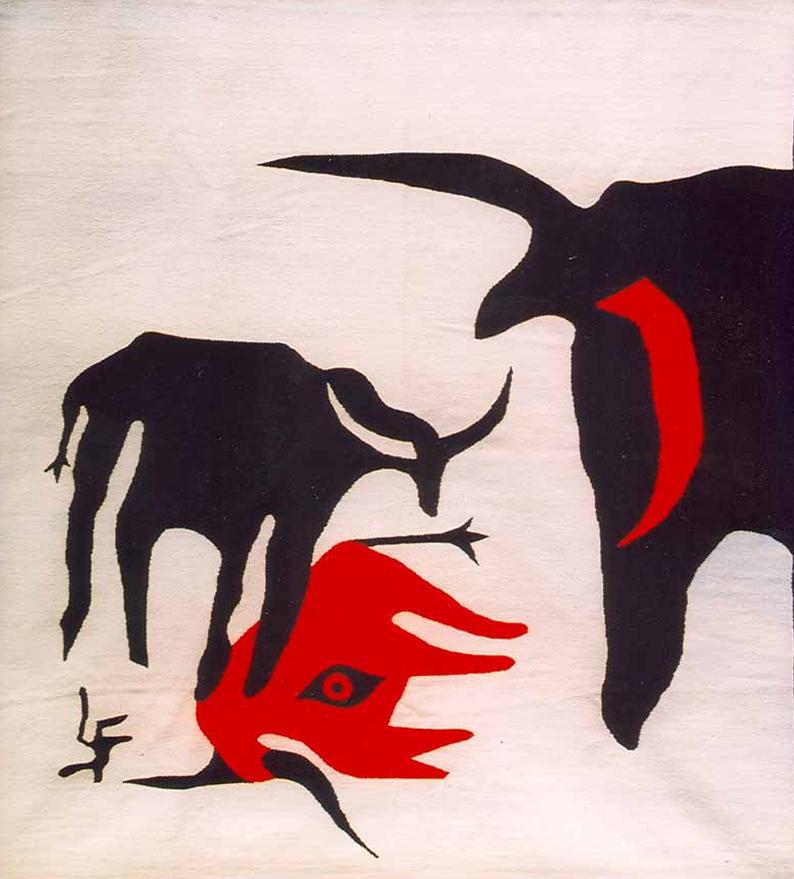
Black Animals. Tapestry.
Technique: wool, synthetics. Year: 1990. Ferghana.
The tapestry produced by Nina Petrosova, textile artist.
Collection of the author.
About the Project "The Sepia of Non-Mention"
This project alludes to the bygones of the past, outside the ideology of the portrayed similarity, outside the circumstances of social tension, outside is the subordination of social status, but only in a vague impulse to behold an emanation of the last century in its selectness, to capture the stay of the individual who has already quit the world in the atmosphere of the passed. Who and what he was once: worker, intellectual, commissar, basmach, communist, etc. does not matter, because canvasses in the silk-screen technique are, according to Fergana culturologist Alexander Ivanovich Kuprin, a testifying fact of the art itself in its providential substance when the native is higher than the true and just, by transfer of the image to the publicity, so that it could become, for at least someone, a part of time regained. As Rilke said, "once means now". The project "The sepia of non-mention" as an object of exposition in the exhibition hall establishes a kind of a script of photographic anonymity of authorship in the gap between the historical and mythological existence. It is almost a humble will of supreme powers to slightly open to us the fleetingness of the last perception of the world in the point of what it once was with you in the body of the father, mother, close friends and relatives. In addition, black and white fluids in the screen visibility of sheets are in the renovated print in the elusive intention of contemporary art to assign a certain place of fixedness, where a mark of the instantaneous becomes a message of possible.
Thereby, the facial statics of photos dissected by the anonymity of scratches, swellings, cut-downs and negligence of darkening stains awakens by the figurativeness of ordinary tranquility and genuineness of the inescapable everyday practice. We hear a man's voice on the air of the exhibition "broadcasting" from the loudspeaker aluminum case; he focuses the nimbus of the hospitable-to-strangers case in the amalgam of faded photos. His reading reproduces the effect of visual navigation on the other side of the event, "where the things agreed before you to be considered as the other." In addition, the voiced performance relays the call signs of the poetic text again and again and mimetically reproduces the metaphorics of a fragment from Jean Cocteau's film "Orpheus". It should be noted that the pixel grid of the stencil print on the surface of bleached coarse calico sort of directs the fleshliness of fabric tissues to be a match for the biblical shroud or the grave-clothes of a forgotten Sufi and seems to be likened to an empty shot which keeps the starched heat of first love. In a rectangular hall, a telegraph pole leaning against the metal frame of the red bicycle and a stumpy hanging of sheets on the clothesline keep within an object conception of the visibility of the installation as a mystery of place in the eventlessness of an old courtyard, this is a response, bringing to us a documentary look around in the cavity of the warmth of the widespread reticence. Peering into the whitishness of the images you invariably recognize a distance of unattainable proximity of simple things welcomed by a shape-generation force of the creative act, which, in fact, every time changes in a new way the optics and the very understanding of the subjects. This project consists in the idea of the necessity to fix a sign of the very impossibility of art to influence anything and in the urgency of the poetic voluntarism to recode itself in the sources of the same vibration. This is the internal sharpening of the photographic matter involved in waiting for the inevitable moment when the cooing air will manifest itself by the face of growing dusky sepia. On top of all, in one of the photos, I remember, there was a wooden porch, which was not even noticed in childhood , and only after a long span of time you suddenly realize that it was a donation of an imperceptible flash in the then sensation of your parents and loved ones. The sunlight, the gate, the yard, neighbors, the red dog called Keshka, the vineyard twining on the roof of the house, the room cool in the summer heat, a ditch on the side of the road, withered grass along the sidewalk, a corner of the house at the intersection of the quiet streets, unhurried conversation with a friend etc. These signs have uttered into our mouths a momentary this-sidedness of the dust patronized by the dust itself in the offering of our appearance at the altar of the with a portrait semblance to the others and the Other.
The text by Vyacheslav (Yura) Useinov edited by Shamshad Abdullayev.
Project by Vyacheslav Useinov and Shamshad Abdullayev.
Translator: Natalya Nadolskaya
